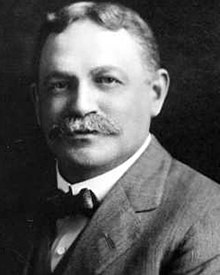William Nicholas Blessed
William Nicholas Selig (born March 14, 1864 in Chicago , Illinois , USA ; † July 15, 1948 in Los Angeles , California , USA ) was a pioneer in the US film industry.
Life
Blessed grew up in Chicago. He worked as a variety artist and produced a Minstrel Driving Show in San Francisco as a teenager. One of the actors was Bert Williams , who became a leading African American entertainer. In 1894, Selig saw Thomas Edison's kinetoscope at an exhibition in Dallas , Texas. He returned to Chicago, opened a small photo studio, and began researching how he could make his own moving images without paying a fee to patent holder Edison. According to Selig's reports, he met a metalworker who had been fixing a camera made by the Lumière brothers, and with whom he built his own camera. In 1896, Selig founded the Selig Polyscope Company in Chicago, one of the first film studios in America. He began creating news, travelogues, and films for Chicago companies.
In 1909, together with director Francis Boggs , Blessed was the first producer to build a studio on the west coast in Edendale near Los Angeles . The southern California weather allowed filming outdoors for much of the year and offered varied geography that could represent other parts of the world. In 1911, Boggs was murdered by a Japanese gardener and Selig was injured in the arm while trying to defend him. Selig produced nearly a thousand films and discovered many new film talents such as Roscoe Arbuckle , Gilbert M. Anderson and Tom Mix . The 1914 Spoilers , a western set in Alaska, is often cited as its greatest hit.
In 1915, at great expense, he created a zoo in east Los Angeles, with hundreds of animals that he used for jungle films while shooting. He then moved his studios to Los Angeles. Meanwhile the First World War began and the profits of his European enterprises collapsed. When the war ended, the studios began producing longer and more elaborate films. Selig's company was no longer competitive and he closed the studio in 1918. He still had the hope of expanding his zoo into an amusement park, but this project failed. He then rented his animals for movies. He finally lost his property during the Great Depression of the 1930s. He then became a literary agent and sold scripts for films.
William Selig died on July 15, 1948. His ashes were buried in the Hall of Memories in the chapel of the Pines Crematorium in Los Angeles.
For his services to the film industry, William Selig received a star on the Hollywood Walk of Fame at 6116 Hollywood Boulevard. In 1948, Selig and several other early film producers and directors, such as George K. Spoor and Albert E. Smith , were honored, along with an honorary Oscar, for their roles in building the film industry.
Filmography (selection)
- 1908: The Count of Monte Christo
- 1914: The Spoilers
- 1919: Ravished Armenia
literature
- Christine Wunnicke : Selig & Boggs. The invention of Hollywood. Berenberg, Berlin 2013, ISBN 978-3-937834-59-7 . (Narrative)
Web links
- William Nicholas Selig in the Internet Movie Database (English)
- Pictures by William Nicholas Selig In: Virtual History
| personal data | |
|---|---|
| SURNAME | Blessed, William Nicholas |
| BRIEF DESCRIPTION | US film industry pioneer |
| DATE OF BIRTH | March 14, 1864 |
| PLACE OF BIRTH | Chicago , Illinois , USA |
| DATE OF DEATH | July 15, 1948 |
| Place of death | Los Angeles , California , USA |
